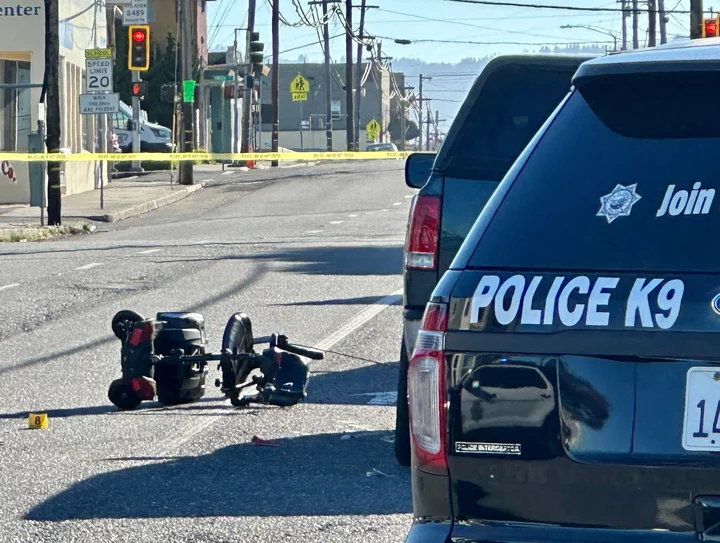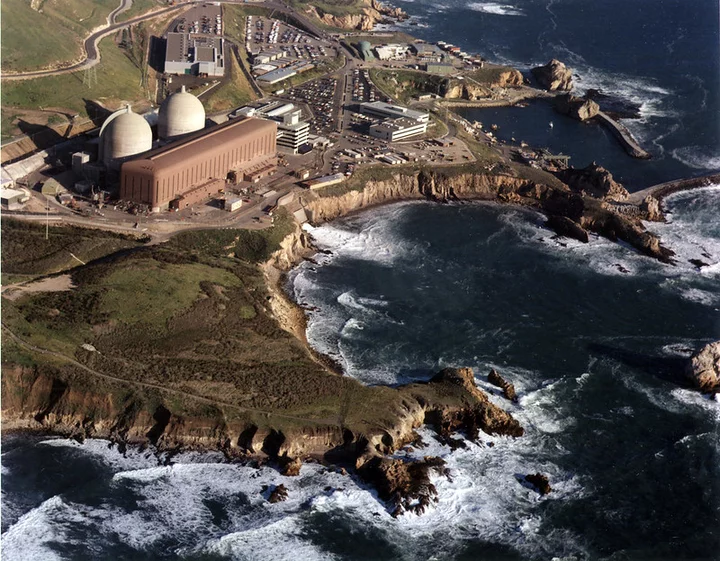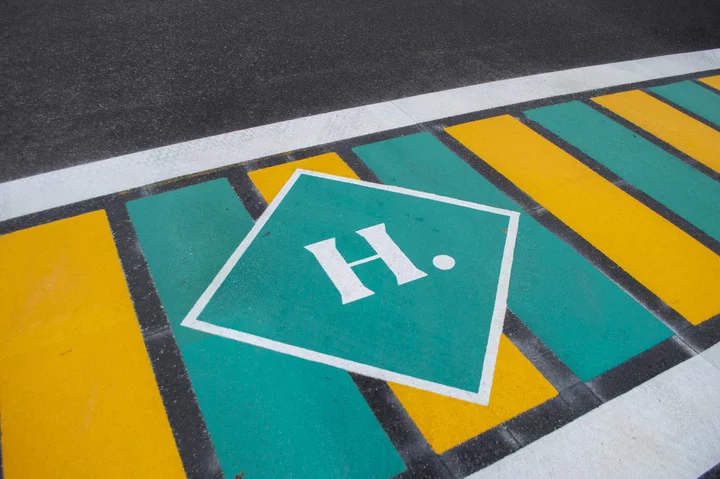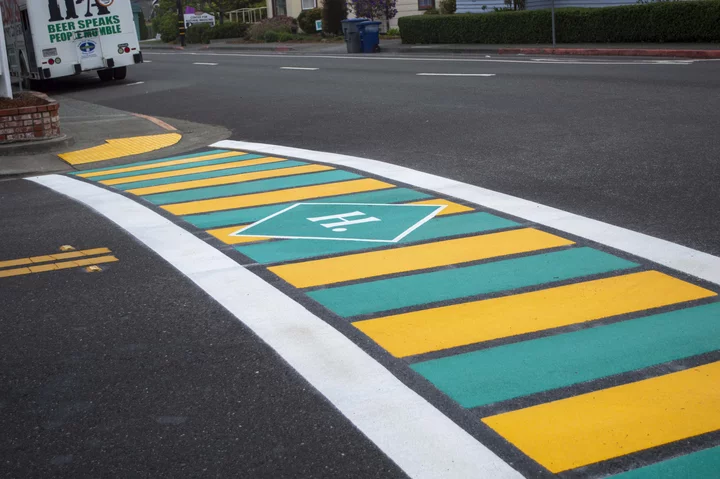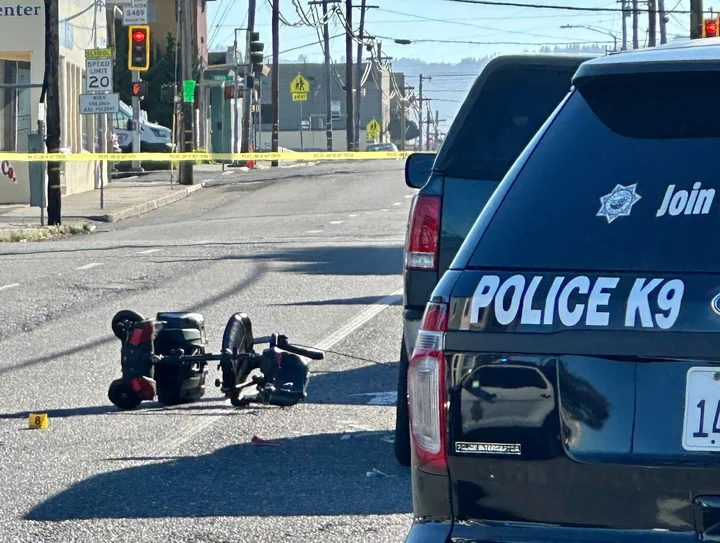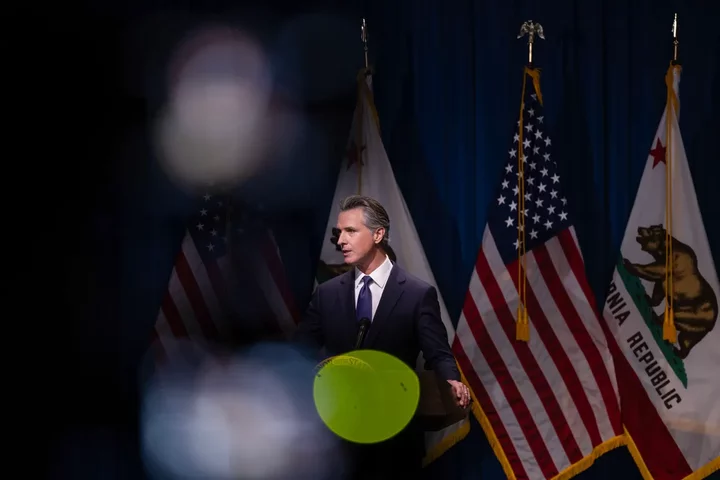EPD Releases Details on This Morning’s Fatal Collision; Everyone Involved is Cooperating, Police Say
LoCO Staff / Friday, Sept. 27, 2024 @ 1:17 p.m. / Traffic
Photo: Andrew Goff.
PREVIOUSLY:
###
Press release from the Eureka Police Department:
On September 27, 2024 at approximately 7:58 a.m., Eureka Police Officers were dispatched to the vicinity of W. Harris and Elizabeth Streets in Eureka on a report of a vehicle versus pedestrian traffic collision. Humboldt Bay Fire (HBF) personnel were also dispatched and arrived on scene first, locating an unresponsive male subject in the roadway. HBF personnel initiated immediate life saving efforts and were supported by City Ambulance. Despite their efforts, the pedestrian died at the scene. A member of EPD’s Traffic Investigations Team, along with Detectives from the Criminal Investigations Unit and a Forensic Analyst, responded to the scene and took over the investigation.
The initial investigation has revealed that a male was crossing W. Harris Street on his mobility scooter outside of a crosswalk and away from the intersection of W. Harris and Elizabeth Streets. Vehicle 1 was traveling east in the left lane of W. Harris Street and struck the scooter in the roadway. The male on the scooter was knocked from the scooter and into the roadway. Vehicle 2, which entered W. Harris Street from Prospect Avenue, failed to see the male lying in the roadway and struck him with their vehicle. Both vehicles and all involved parties, including witnesses, were located on scene and are cooperating with the investigation. There were no injuries reported to the occupants of the vehicles.
The name of the victim will be released following the notification of the next of kin. Alcohol and drugs do not appear to be a factor in this collision. Speed also does not appear to be factor, as witnesses described the vehicles traveling at speeds that were not excessive. The rising sun, which created visibility issues, does appear to have been a factor in this collision.
This is an ongoing and active investigation and EPD is asking anyone that may have information about this collision to contact Field Training Officer Mark Sheldon at 707-441-4300.
BOOKED
Yesterday: 4 felonies, 16 misdemeanors, 0 infractions
JUDGED
Humboldt County Superior Court Calendar: Yesterday
CHP REPORTS
No current incidents
ELSEWHERE
RHBB: Coasties Rescue Five after Boat Runs Aground in Humboldt County
RHBB: Woman Receives Major Injuries After Vehicle Plunges Off Trinity Dam Blvd Embankment
RHBB: #RedFire Ignites West of Redway; Air and Ground Resources Responding
Conflicted Board of Redwood Coast Energy Authority Declines to Accept ‘Free’ Nuclear Power From Diablo Canyon
Ryan Burns / Friday, Sept. 27, 2024 @ 12:31 p.m. / Energy , Local Government
The Diablo Canyon Nuclear Power Plant, in San Luis Obispo County, is the last remaining operational nuclear plant in California. | Image via the Nuclear Regulatory Commission, CC BY-NC-ND 2.0.
###
At a meeting held Thursday evening in Eureka’s Wharfinger Building, the board of directors of the Redwood Coast Energy Authority (RCEA) opted not to accept an allocation of nuclear energy into the mix of power sources it purchases on behalf of local ratepayers.
Through PG&E’s California’s Community Choice Aggregation program, RCEA functions as the default provider of electricity generation for the vast majority of consumers in Humboldt County. Since 2017, the agency has been purchasing electricity from a variety of mostly green, renewable sources and then re-selling that energy to its roughly 63,000 local customers at slightly lower rates than PG&E customers would otherwise pay.
The dilemma the board faced last night was this: Should RCEA accept a short-term allocation of the power being generated by the Diablo Canyon Nuclear Power Plant — power that all electricity users in California are already paying for — or should it refuse on principle given environmental concerns such as the problem of safe nuclear waste storage?
At last month’s RCEA meeting, the board heard from Jaclyn Harr, an account director with nonprofit portfolio management company The Energy Authority. She reminded board members that the two nuclear reactors at the Diablo Canyon plant, owned and operated by PG&E, were scheduled to be retired from service by the end of 2025. But 2022 legislation will allow the reactors to keep running through at least October of 2030.
While California is working to transition to renewable energy, it’s had trouble getting clean alternatives to carbon dioxide-spewing sources online as quickly as anticipated. And so, in 2022, at the urging of Gov. Gavin Newsom, the state legislature approved a $1.4 billion loan to PG&E to help maintain the reliability of California’s power grid by keeping Diablo Canyon running. It currently supplies 10 percent of the energy in the state grid.
As part of the deal to keep the nuclear plant operating, all jurisdictional entities under the California Public Utilities Commission (CPUC) are paying a share of the costs, and they all have the option of receiving an allocation of the power generated by Diablo Canyon. This power would be “free” in the sense that all ratepayers across the state, including us here in Humboldt County, are already paying for it, whether we like it or not.
But RCEA has a longstanding provision in its risk policy prohibiting the inclusion of nuclear power in its portfolio, except for short-term purposes. Members of RCEA’s board of directors, including Eureka City Councilmember Scott Bauer, voiced serious concerns last month about the long-term consequences of storing nuclear waste, including isotopes such as uranium-235, which remains radioactive for hundreds of millions of years.
At the same time, however, RCEA is working to reach a 100 percent carbon-free energy supply in the coming years, and the nuclear power coming from Diablo Canyon technically meets that criteria.
And then there are financial concerns. The cost of emissions-free energy resources have been increasing, especially when looking for long-term deals, and while RCEA has some financial reserves, is it fiscally prudent to turn down “free” electricity? Accepting the allocation would save the agency about half a million dollars, which represent about 5.4 percent of RCEA’s net losses for 2025.
Specific allocation amounts have not yet been published, but according to a staff report, RCEA’s allocation would likely only meet about 2% of 2025 power portfolio.
“So it’s a modest savings, either of money or a modest savings in [greenhouse gas] emissions,” RCEA Power Resources Director Richard Engel told the board. He said staff knows of two other community choice aggregators in California that have accepted the allocation.
RCEA board members and staff gather at the Wharfinger Building/
During the public comment period, a number of people urged the board to turn down the allocation.
“I think it would be reprehensible of RCEA to accept nuclear power into the mix of quote-unquote, clean energy that we accept,” said Arcata resident Kathleen Marshall, adding that it’s not carbon neutral to build a nuclear power plant or mine for uranium. She also voiced concerns about the potential for disaster if an earthquake were to strike either near Diablo Canyon or here in Humboldt, where spent nuclear fuel rods are stored along Humboldt Bay.
Fellow Arcata resident Dave Ryan called nuclear power “a really messy source of energy,” and with more community solar power projects coming online, including a recently approved 2.8 megawatt array along Hwy. 36, Ryan urged the board to “exercise some integrity” and “send a message that you’re not going to be an agency to support this.”
Cal Poly Humboldt grad student Alexander Brown spoke about the long-term ramifications of storing spent nuclear fuel, saying, “I don’t think, as a nation, we know what we’re doing with it.”
Michael Welch, reading a statement on behalf of the environmental organization Redwood Alliance, also urged RCEA to reject the allocation, arguing that accepting it would send the wrong message.
“Any amount of saying ‘yes’ to nuclear energy only bolsters the efforts of the nuclear industry,” he said.
When the matter came back to the board, Bauer reiterated the concerns he expressed at last month’s meeting.
“We’re always looking at how to run efficiently,” he said. But he also argued that RCEA has a responsibility to the community, to the world and to the “800 generations, at least” that could be forced to coexist with radioactive waste. “[O]ur responsibility should be to not accept it,” he said.
But fellow Director Skip Jorgensen, who represents the City of Ferndale on the board, expressed concerns about RCEA’s dwindling financial reserves and said he’d favor a one-year agreement to accept the allocation “with my nose pinched.”
Director Elise Scafani, representing the City of Blue Lake, asked whether accepting the allocation would be more palatable if RCEA dedicated the half-million-dollars in savings to the development of local, renewable energy.
“We know that this energy is being generated … whether we accept it or not,” she said. “What can we do with that reality to make our overall picture going forward improved?”
Humboldt County Supervisor Mike Wilson, an alternate on the board sitting in on behalf of fellow Supervisor Natalie Arroyo, spoke at length about various dimensions of this quandary, touching on such matters as the importance of fiscal responsibility and the scientific reality that, despite the creative dynamics of community choice aggregation, the vast majority of electricity actually being used here in Humboldt County comes via the fracked natural gas that powers PG&E’s Humboldt Bay Generating Station just south of Eureka.
As such, Wilson said, RCEA’s choice really comes down to the importance and efficacy of sending a message. “I don’t know if we’re going to lead the charge or just be sort of standing out in the cold” if the agency takes a stand and rejects its allocation, he said.
He also noted that Arroyo was leaning toward receiving the allocation, though he said his own heart wants to do away with nuclear power generation.
Director Jason Ramos, representing the Blue Lake Rancheria, said he agreed with Bauer and thinks accepting nuclear power would dilute RCEA’s mission. “Doesn’t seem worth it to me,” he said. [DISCLOSURE: The Blue Lake Rancheria is a minority owner of the Outpost’s parent company, Lost Coast Communications, Inc.]
Bauer made a motion to not accept the allotment. Alternate Director Michelle Fuller, who was sitting in for Board Chair Sheri Woo, offered to second the motion but she was reminded that as the representative for the Humboldt Bay Municipal Water District, she’s a non-voting member.
Bauer’s motion never did receive a second.
Scafani then made a motion to accept the allocation for calendar year 2025 and dedicate the savings to developing local, renewable energy. Jorgensen seconded the motion after asking for inclusion of a provision to revisit the decision early next year. He also quipped, “Getting clean is a dirty business.”
Several board members were absent, and when it came time to decide, the motion received only two “yes” votes — Scafani’s and Jorgensen’s. The absent board members count as “no” votes in RCEA’s proceedings, In order for the motion to pass, a staff member explained that every voting member present would need to vote “yes,” and thus the motion failed.
A letter will be sent to the CPUC explaining the agency’s decision, and staff will come back at a future meeting to ask the board whether it would like to revise its current nuclear policy.
The Sheriff’s Office is Getting a $30,000 Heat-Vision Camera to Help With Aquatic Rescue Operations
Dezmond Remington / Friday, Sept. 27, 2024 @ 11:25 a.m. / Local Government
Promotional video for the FLIR M300 series.
Disposable cameras are 12 bucks apiece, an off-brand Polaroid costs about $75, and a cheap DSLR goes for $500 — but none of those can see people in the dark, stay still while going over waves or make objects 30 times larger. The $30,000 camera the Humboldt County Sheriff’s Office is about to purchase can do all of that and more.
The FLIR M364C thermal camera can see heat even in foggy conditions, and the Sheriff’s Office will buy one with funding from the state’s Boating Safety & Enforcement Equipment Grant Program, which is run by California State Parks.
The Sheriff’s Office wants it the camera because it will make finding people stuck in the water much easier — a common problem in a place where waterways are often foggy and even small waves can flip a kayak over.
“The technology of thermal cameras includes detection of invisible heat radiation emitted by objects, regardless of lighting conditions,” Public Information Officer Meghan Ruiz told the Outpost. “With Humboldt County’s adverse weather conditions of heavy rain and fog, a FLIR device helps law enforcement identify issues with increased efficiency.”
About $1.3 million in total grant money from the Boating Safety program was split between various sheriff’s offices around California.
“Recreational boaters underestimate the power of the water, how cold the water is, and how quickly a minor incident can turn fatal … FLIR cameras allow for situational information that cannot be seen with the naked eye during these adverse conditions and aid deputies with navigation during darkness,” reads a staff report from the sheriff’s office. “Having this equipment helps create a safer community on our waterways and helps partnerships with other agencies such as the U.S. Coast Guard.”
How Do You Like These New Green and Gold, Cal Poly Humboldt-Branded Crosswalks?
Dezmond Remington / Friday, Sept. 27, 2024 @ 9:57 a.m. / Infrastructure
The new, colorful, branded crosswalk at 14th and G. Photo: Dezmond Remington.
What’s green and yellow all over and costs $52,000? Nope, it’s not a sports car with a flashy paint job or the world’s wealthiest duck, though water is supposed to run off of it pretty easily. It’s four new crosswalks on G Street in Arcata, branded with Cal Poly Humboldt’s logo and shining a blinding neon.
The crosswalks are part of the “Green and Gold Corridor” project that Cal Poly Humboldt and the city of Arcata started working on together in 2022, when they decided to turn G Street into a nexus between the university and the city. Other additions to the street included Cal Poly Humboldt banners and flags. These crosswalks, located on G Street where it intersects at 14th and 8th streets, are the last addition to the collaboration.
Emily Sinkhorn, Arcata’s environmental services director, told the Outpost that the city and Cal Poly Humboldt felt the crossworks would beautify the area and be symbols of the link between Cal Poly Humboldt and the university.
“We saw an opportunity for G Street as a key connector between the city and the university,” Sinkhorn said, “and the crosswalks as physical reminders of that connection.”
The crosswalks were designed by Humboldt’s marketing team and reviewed by the city’s engineering and transportation departments. They’re made out of non-slip highly visible plastic. $12,000 came from the city, courtesy of American Rescue Plan Act money from 2021. Cal Poly Humboldt paid for the remaining $40,000. A Sacramento-based contractor put in the sidewalks.
“The City and the University are always working together to strengthen the connection and relationship between students and the Arcata community, like hosting events in the downtown area, opening The Campus Store near the Plaza, and now, through the ‘Green & Gold Corridor,’” a statement from Cal Poly Humboldt to the Outpost said. “All of these efforts help students feel a stronger sense of belonging, make them feel more welcome, and encourage pride in the town where they live and learn.”
BREAKING: Eureka Police Responding to Fatal Traffic Collision on West Harris Street
Ryan Burns / Friday, Sept. 27, 2024 @ 9:16 a.m. / Traffic
Photo by Andrew Goff.
###
UPDATE, 1 p.m.:
- EPD Releases Details on This Morning’s Fatal Collision; Everyone Involved is Cooperating, Police Say
###
Original Post: Officers with the Eureka Police Department are responding to a fatal traffic collision that occurred this morning on West Harris Street between Spring and Albee, southeast of Winco.
“If possible, please use alternate routes of travel,” the department advised via social media. “If utilizing W.Harris, please be patient as traffic flow is significantly impacted.”
An eyewitness tells Kym Kemp that the victim was a resident of the area. At the scene, officers have set up visual barriers on either side of the victim. A motorized medical travel scooter was left lying on its side in the righthand lane.
On Facebook, an employee of Poletski’s Appliance Center writes, “All of us at Poletskis are very sad to see this. We all became friends with this man he comes by here almost daily and talks to the workers. May he rest in peace ![]() .”
.”
Eastbound traffic on Harris is being re-routed through the Winco parking lot.
We will update as more information becomes available.
Economists Like Newsom’s Plan to Help Control Gas Prices. Refiners Don’t.
Malena Carollo / Friday, Sept. 27, 2024 @ 7 a.m. / Sacramento
California drivers pay a persistent “mystery surcharge” when they fill up, a UC Berkeley economist says. Photo by Larry Valenzuela, CalMatters/CatchLight Local
Fall is in the air, and that means California drivers are gearing up for seasonal price increases at the pump. A plan by Gov. Gavin Newsom to hold down those spikes cleared the Assembly petroleum committee Thursday.
The proposal, the focus of a special legislative session, is set to head to an Assembly floor vote Tuesday.
California drivers typically pay higher prices for gas than the rest of the country, which is felt most acutely when seasonal maintenance at the state’s refiners pushes up prices. Newsom’s proposal would instate a yet-to-be-determined mandatory minimum amount of fuel that those refiners need to have on hand to lessen such spikes. The petroleum industry has decried the plan as costly and impractical, while Newsom’s office said the price spikes themselves are a result of corporate greed.
Experts said that the storage requirements would dampen the spikes as intended (the state projects up to about $2 billion in savings for California drivers) but wouldn’t address a large portion of the price difference between California and the rest of the country.
“This is not a panacea for all the issues in the California gas market,” Neale Mahoney, Stanford University economist, said in an interview with CalMatters. “This is, I would argue, an economically sound, well-targeted policy response to the problem of gas prices spiking whenever we have a disruption, even though we know disruptions happen and we should have some level of preparation.”
This is, I would argue, an economically sound, well-targeted policy.
— Neale Mahoney, Stanford University economist
Refiners argue that building up a reserve during the summer months, when demand is high and fuel is more challenging to blend, could lead to higher prices. They have also said that they lack tankage to store a reserve, an assertion the state and economists have pushed back on, and that it would be expensive and time-consuming to build more.
Seasonal maintenance drives higher prices, profits
Until the last decade, experts said, the difference between California’s prices and the national average was primarily made up of state taxes on gasoline and environmental fees. California also has a more emissions-friendly blend of gas than the rest of the country, which pushes up the cost further. But after a 2015 explosion at a refinery in Torrance, Calif., owned by ExxonMobil at the time, the premium paid for gas in California rose still further, vastly outpacing the national average.
The high baseline price of gas in California makes price spikes all the more painful for consumers. The main driver for the spikes, according to the governor’s office and experts, is the small number of refiners in California and their seasonal maintenance schedule.
California in recent years has seen a consolidation of refinery ownership. When a refinery goes down for maintenance, it is not contributing the same amount of fuel to the market as it typically does. That makes remaining fuel on the market more valuable, driving up prices temporarily.
Newsom’s proposal seeks to smooth prices during these maintenance shutdowns. Legislation from 2022 gave the state access to information from California’s refineries, including how much fuel they have on hand. The state then determined that the lack of supply during maintenance is a “key factor” behind the spikes.
Requiring refiners to stockpile higher levels of gas would ensure “we have enough supply that it doesn’t incentivize that trading behavior that increases prices,” said California Energy Commission spokesperson Lindsay Buckley.
Refiners in this current market won’t accumulate enough gas to dampen spikes on their own because they make more money when prices spike and so “don’t have the incentive to do what a competitive market would do and do what’s in the interest of the California customer,” Stanford’s Mahoney said
Experts also point out that Australia and Japan have put into place reserves to smooth out price spikes.
Potential problems with stockpiling gas
For all their promise, gasoline reserve mandates need to be carefully implemented, experts said. Newsom’s plan is vague, leaving many specifics, including the size of the reserve itself, up to a to-be-created panel. Buckley said it would be up to Energy Commission staff to implement the plan once it’s fleshed out.
But University of California Berkeley economist Severin Borenstein, who testified at a hearing on Newsom’s proposal last week, said there also need to be safeguards against using the gasoline reserves to score political points rather than to limit price spikes.
“Once you have inventory like this, it is going to be very tempting for whoever has political power to try to release that inventory when it is helpful to them to push down gasoline prices,” he testified at the hearing before the Assembly Committee on Petroleum and Gasoline Supply.
The Western States Petroleum Association, an industry group, said in a Sept. 19 letter to the state that not only is there not enough supply to store additional excess of, there isn’t enough storage for the reserve, and building even one more tank would take “the better part of a decade” and cost “tens of millions of dollars.”
“You’re asking a just-in-time system to slow down and back up the pipes just in case you have price volatility,” Mark Nechodom, senior director of science and technology for WSPA, said in an interview with CalMatters.
You’re asking a just-in-time system to slow down and back up the pipes just in case you have price volatility.
— Mark Nechodom, senior director of science and technology, Western States Petroleum Association
Experts and Buckley told CalMatters that no extra storage should need to be built, as the stock could be built up during non-maintenance times of the year. The state Division of Petroleum Market Oversight has said that refiners ended this summer with 2.4 million fewer barrels in storage than the 12.3 million barrels they had at the start of the year, a reduction the refiners have blamed on the scramble to meet demand during the busy travel season and on the fuel blend they produce in the summer, which is more difficult to refine. Refiners who lack storage capacity could buy storage credits from other refiners to make up the difference, experts added.
An amended version of Newsom’s plan would require that refiners store gas in existing tanks rather than build new ones, Politico reported.
The refiners say Newsom’s plans add to a long list of requirements that are disincentivizing production of gas in the state, and that this would further hinder investments, which could increase prices. “The uniqueness on top of uniqueness on top of uniqueness has made this not the kind of environment that refiners want to continue to invest in,” said Eloy Garcia, lobbyist for industry group the WSPA at last week’s hearing. “You are further and further making this a unique refining environment when you need refiners to stay in California.”
Another caveat on Newsom’s plan is that while it could help reduce price spikes, it won’t solve the broader issue of California’s higher gas prices, experts said. One of the largest contributors to California’s gas prices exceeding other states’ is something Borenstein has dubbed the “mystery gasoline surcharge.” Since the 2015 Torrance explosion, gas prices have routinely been higher than the rest of the country, and taxes, environmental fees, and supply shortages don’t explain it. The “mystery surcharge” accounts for about 40 cents per gallon, he said, or about $60 billion from Californians since 2015.
It’s not clear why prices remained high for years after the Torrance explosion; the refinery came back online a year later. The state sued two multinational gasoline firms for allegedly using the incident to launch “a scheme to drive up gas prices for their own profit.” A federal judge gave preliminary approval to a $13.9 million settlement of the case last month.
Some factors that might be affecting the price premium, Borenstein said, are California’s unique relationship with various industry players, from suppliers down to gas stations. The state has a higher share than the rest of the country, he said, of both branded gas (think big producers like Chevron) and contracts between refiners and gas stations – called a “dealer tank wagon” arrangement – that impose provisions like fees and fixed charges, giving refiners more influence over the consumer-facing price.
“It’s pretty much unheard of outside of California,” he said. And while refiners say they don’t control the price at the pump, “they have a lot more control over retail stations.”
This, he said, may be contributing to another issue unique to California, in which there are significant price disparities between different gas stations, even within the same city. Discount stations, for example, that don’t use big brands’ gasoline, often have significantly cheaper gas prices.
And while the state government is currently investigating the mystery surcharge, storage requirements likely won’t solve for it.
###
CalMatters.org is a nonprofit, nonpartisan media venture explaining California policies and politics.
Gavin Newsom Is Vetoing 1 of Every 5 Bills. Here’s Why
Jenna Peterson / Friday, Sept. 27, 2024 @ 7 a.m. / Sacramento
Gov. Gavin Newsom addresses the media during a press conference unveiling his 2024-25 January budget proposal at the Secretary of State Auditorium in Sacramento on Jan. 10, 2024. Photo by Miguel Gutierrez Jr., CalMatters
Heading into the final four days before his midnight Monday deadline, Gov. Gavin Newsom will need to decide whether to sign or veto 465 bills still on his desk.
So far, he’s blocked 102 of 526 measures he’s acted on since the Legislature adjourned Aug. 31, or nearly 20%. That compares to a 15% veto rate in 2023, when he blocked 156 bills. He had a similar veto percentage in 2022, including some significant bills. In 2021, he vetoed fewer than 8%.
While the Legislature can override vetoes, it takes a two-thirds vote in both the Assembly and Senate and that hasn’t happened since 1979. Governors can also allow bills to become law without their signature, but that doesn’t occur very often, either.
So in most cases, lawmakers try again the next session, often tailoring their proposals to avoid Newsom’s veto pen.
“In most instances, legislators try to work with the governor and the governor’s administration in trying to address the concerns that are in the veto message, as opposed to saying simply that their approach is the right one,” said veteran lobbyist Chris Micheli.
On some high-profile and contentious bills, whatever Newsom says publicly about why he issued a veto, there can be a healthy dose of politics involved — as well as the push and pull of various interest groups.
“Whether it’s an election year or it’s not an election year, political considerations will impact not just the legislation going through the legislative process, but also whether or not a bill results in a gubernatorial signature or veto,” Micheli said. “But that’s a small number by my estimate.”
A Newsom spokesperson said the veto messages speak for themselves.
Here are the main reasons Newsom gives for his vetoes. (When he gives multiple reasons, it’s counted in all categories.)
It’s bad policy
Newsom cited policy problems as his reason for vetoing one third of the bills — the second largest category. These are bills that he didn’t agree with or had language that was too broad.
For example, Senate Bill 804 would have let community service officers testify at preliminary hearings. In the governor’s veto message, he wrote that the bill raises concerns about “the reliability of evidence presented at a critical stage of criminal proceedings.”
SB 1170 would have allowed candidates to use campaign funds to address mental health-related issues that arise during a campaign, but Newsom wrote that it could allow for other changes to campaign fund use that go “beyond what a reasonable donor would expect.”
And SB 1432 aimed to let hospitals seek five more years to meet seismic safety standards. “In the aftermath of an earthquake, not only would these hospitals be unable to provide emergency care to victims, but they would also require emergency response efforts to be diverted to rapidly evacuate and transfer patients to other facilities,” Newsom said in his veto message.
It’d strain the budget
For the third year in a row, the most common reason Newsom gave for vetoing a bill was budget concerns — about 40%.
Newsom and the Legislature had to make sweeping cuts to some programs and dip into the state’s reserves to close the $56 billion budget hole over the next two years. The deficit also played a central role in decisions during the session to shelve hundreds of bills. The state’s financial crunch accounted for 41% of vetos last year, according to Micheli.
“Every governor and his or her staff, they’re going to look at the policy implications. Second, the fiscal implications,” Micheli said. “A negative fiscal consideration this year, last year and the prior year has been an overriding factor in many instances.”
For example, the governor vetoed AB 1840, which would have allowed undocumented applicants to apply for a homebuyer assistance program. In his veto message, Newsom wrote that there is “finite funding” available and that this change would have to be considered in the state budget.
Another bill that Newsom squashed because of the budget was AB 544, which would have provided funding so three counties could test in-person voting in jails.
But even if an author attempts to address their bill in the budget, it may not be enough. State Sen. Caroline Menjivar, a Van Nuys Democrat, secured $5 million for SB 954, which would have required public high schools to provide condoms to students.
Newsom vetoed the bill, writing that “one-time funding does not adequately address the fiscal concerns associated with this bill.”
It may not be legal
For a couple of bills so far, Newsom said that courts should decide on an issue before he gives his signature.
His second veto of a bill relating to undocumented Californians, SB 2586, would have let undocumented students work on campus. In his message, Newsom wrote that, “it is critical that the courts address the legality of such a policy and the novel legal theory behind this legislation before proceeding.”
It’s up to local officials
Sometimes Newsom vetoes a bill because it’s an issue that could be solved at the local level.
For example, AB 1950 would have created a state task force to research reparations for people displaced in the Chavez Ravine area in Los Angeles. In his veto message, Newsom wrote that it is “an issue best addressed by stakeholders closest to the Chavez Ravine community.”
It’s not needed
Newsom vetoed another large percentage of bills because he sees them as unnecessary given the work the state is already doing on an issue.
SB 936 would have required Caltrans to conduct a road safety study and come up with an improvement plan. In Newsom’s message, he wrote that Caltrans is already working on road safety, so the bill would be redundant.
Despite the governor’s explanation of Caltrans’ current efforts, bill author Sen. Kelly Seyarto, a Republican from Murrieta, wrote in a press release that he is “deeply disappointed by the veto, as it sends a message that road safety isn’t being prioritized at a time when fatalities are on the rise.”
AB 2903 would have required state homelessness programs to more closely track and report spending data. However, Newsom wrote in his veto message that he’s already signed legislation that strengthens reporting requirements for California’s two largest programs.
That didn’t satisfy the bill author, Assemblymember Josh Hoover, a Republican from Folsom. “Governor Newsom is doubling down on his failed response to homelessness,” Hoover posted on X. “Our state has spent billions of taxpayer dollars in recent years only to see the homeless population increase statewide.”
It’s too soon
Newsom dubbed another small portion of bills as “premature,” such as SB 1220, which would have banned agencies from staffing call centers with AI or automated decision-making systems if it gets rid of a human job.
Last year, Newsom signed an executive order for the state to evaluate how to use AI in its workforce, so the bill would create guidelines before the ones from the order are announced, he wrote in his veto message.
SB 1050 would have allowed Californians who had land taken from them or their families for racially motivated reasons to apply for compensation. But implementing the bill is “impossible,” according to Newsom, because there’s no agency to do so.
###
CalMatters.org is a nonprofit, nonpartisan media venture explaining California policies and politics.

